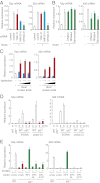Essential contribution of IRF3 to intestinal homeostasis and microbiota-mediated Tslp gene induction
- PMID: 23213237
- PMCID: PMC3529020
- DOI: 10.1073/pnas.1219482110
Essential contribution of IRF3 to intestinal homeostasis and microbiota-mediated Tslp gene induction
Abstract
The large intestinal epithelial cells and immune cells are exposed to a variety of molecules derived from commensal microbiota that can activate innate receptors, such as Toll-like receptors (TLRs) and retinoic acid-inducible gene-I-like receptors (RLRs). Although the activation of these receptors is known to be critical for homeostasis of the large intestine, the underlying gene regulatory mechanisms are not well understood. Here, we show that IFN regulatory factor (IRF)3 is critical for the suppression of dextran sulfate sodium-induced colitis. IRF3-deficient mice exhibited lethal defects in the inflammatory and recovery phases of the colitis, accompanied by marked defects in the gene induction for thymic stromal lymphopoietin (TSLP), a cytokine known to be essential for protection of the large intestine. We further provide evidence that DNA and RNA of the large intestinal contents are critical for Tslp gene induction via IRF3 activation by cytosolic nucleic acid receptors. We also demonstrate that IRF3 indeed activates the gene promoter of Tslp via IRF-binding sequences. This newly identified intestinal gene regulatory mechanism, wherein IRF3 activated by microbiota-derived nucleic acids plays a critical role in intestinal homeostasis, may have clinical implication in colonic inflammatory disorders.
Conflict of interest statement
The authors declare no conflict of interest.
Figures




Similar articles
-
Proinflammatory Th2 cytokines induce production of thymic stromal lymphopoietin in human colonic epithelial cells.Dig Dis Sci. 2010 Jul;55(7):1896-904. doi: 10.1007/s10620-009-0979-x. Epub 2009 Sep 16. Dig Dis Sci. 2010. PMID: 19757042 Free PMC article.
-
TSLP regulates intestinal immunity and inflammation in mouse models of helminth infection and colitis.J Exp Med. 2009 Mar 16;206(3):655-67. doi: 10.1084/jem.20081499. Epub 2009 Mar 9. J Exp Med. 2009. PMID: 19273626 Free PMC article.
-
TSLP expression induced via Toll-like receptor pathways in human keratinocytes.Methods Enzymol. 2014;535:371-87. doi: 10.1016/B978-0-12-397925-4.00021-3. Methods Enzymol. 2014. PMID: 24377934
-
Expression and Regulation of Thymic Stromal Lymphopoietin and Thymic Stromal Lymphopoietin Receptor Heterocomplex in the Innate-Adaptive Immunity of Pediatric Asthma.Int J Mol Sci. 2018 Apr 18;19(4):1231. doi: 10.3390/ijms19041231. Int J Mol Sci. 2018. PMID: 29670037 Free PMC article. Review.
-
The regulation of thymic stromal lymphopoietin in gut immune homeostasis.Dig Dis Sci. 2011 Aug;56(8):2215-20. doi: 10.1007/s10620-011-1587-0. Epub 2011 Feb 12. Dig Dis Sci. 2011. PMID: 21318591 Review.
Cited by
-
Beneficial bacteria activate type-I interferon production via the intracellular cytosolic sensors STING and MAVS.Gut Microbes. 2020 Jul 3;11(4):771-788. doi: 10.1080/19490976.2019.1707015. Epub 2020 Jan 15. Gut Microbes. 2020. PMID: 31941397 Free PMC article.
-
Revisiting the role of IRF3 in inflammation and immunity by conditional and specifically targeted gene ablation in mice.Proc Natl Acad Sci U S A. 2018 May 15;115(20):5253-5258. doi: 10.1073/pnas.1803936115. Epub 2018 Apr 30. Proc Natl Acad Sci U S A. 2018. PMID: 29712834 Free PMC article.
-
Discovering sparse transcription factor codes for cell states and state transitions during development.Elife. 2017 Mar 15;6:e20488. doi: 10.7554/eLife.20488. Elife. 2017. PMID: 28296636 Free PMC article.
-
Bacteroides uniformis CECT 7771 alleviates inflammation within the gut-adipose tissue axis involving TLR5 signaling in obese mice.Sci Rep. 2021 Jun 3;11(1):11788. doi: 10.1038/s41598-021-90888-y. Sci Rep. 2021. PMID: 34083551 Free PMC article.
-
CpG island demethylation and recruitment of SP1 to the promoter region regulates human thymic stromal lymphopoietin expression.Epigenetics. 2025 Dec;20(1):2529358. doi: 10.1080/15592294.2025.2529358. Epub 2025 Jul 14. Epigenetics. 2025. PMID: 40654309 Free PMC article.
References
-
- Rakoff-Nahoum S, Paglino J, Eslami-Varzaneh F, Edberg S, Medzhitov R. Recognition of commensal microflora by toll-like receptors is required for intestinal homeostasis. Cell. 2004;118(2):229–241. - PubMed
Publication types
MeSH terms
Substances
LinkOut - more resources
Full Text Sources
Other Literature Sources
Molecular Biology Databases

